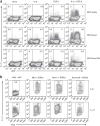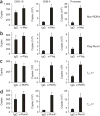Interactions among the transcription factors Runx1, RORgammat and Foxp3 regulate the differentiation of interleukin 17-producing T cells
- PMID: 18849990
- PMCID: PMC4778724
- DOI: 10.1038/ni.1663
Interactions among the transcription factors Runx1, RORgammat and Foxp3 regulate the differentiation of interleukin 17-producing T cells
Erratum in
- Nat Immunol. 2009 Feb;10(2):223
Abstract
The molecular mechanisms underlying the differentiation of interleukin 17-producing T helper cells (T(H)-17 cells) are still poorly understood. Here we show that optimal transcription of the gene encoding interleukin 17 (Il17) required a 2-kilobase promoter and at least one conserved noncoding (enhancer) sequence, CNS-5. Both cis-regulatory elements contained regions that bound the transcription factors RORgammat and Runx1. Runx1 influenced T(H)-17 differentiation by inducing RORgammat expression and by binding to and acting together with RORgammat during Il17 transcription. However, Runx1 also interacts with the transcription factor Foxp3, and this interaction was necessary for the negative effect of Foxp3 on T(H)-17 differentiation. Thus, our data support a model in which the differential association of Runx1 with Foxp3 and with RORgammat regulates T(H)-17 differentiation.
Figures









Similar articles
-
TGF-beta-induced Foxp3 inhibits T(H)17 cell differentiation by antagonizing RORgammat function.Nature. 2008 May 8;453(7192):236-40. doi: 10.1038/nature06878. Epub 2008 Mar 26. Nature. 2008. PMID: 18368049 Free PMC article.
-
Runx1 and RORγt Cooperate to Upregulate IL-22 Expression in Th Cells through Its Distal Enhancer.J Immunol. 2019 Jun 1;202(11):3198-3210. doi: 10.4049/jimmunol.1800672. Epub 2019 Apr 26. J Immunol. 2019. PMID: 31028121
-
Foxp3 inhibits RORgammat-mediated IL-17A mRNA transcription through direct interaction with RORgammat.J Biol Chem. 2008 Jun 20;283(25):17003-8. doi: 10.1074/jbc.M801286200. Epub 2008 Apr 23. J Biol Chem. 2008. PMID: 18434325
-
Transcriptional regulation of Th17 cell differentiation.Semin Immunol. 2007 Dec;19(6):409-17. doi: 10.1016/j.smim.2007.10.011. Epub 2007 Nov 28. Semin Immunol. 2007. PMID: 18053739 Free PMC article. Review.
-
FOXP3 and the regulation of Treg/Th17 differentiation.Microbes Infect. 2009 Apr;11(5):594-8. doi: 10.1016/j.micinf.2009.04.002. Epub 2009 Apr 14. Microbes Infect. 2009. PMID: 19371792 Free PMC article. Review.
Cited by
-
The roles of IFN-γ versus IL-17 in pathogenic effects of human Th17 cells on synovial fibroblasts.Mod Rheumatol. 2013 Nov;23(6):1140-50. doi: 10.1007/s10165-012-0811-x. Epub 2013 Jan 11. Mod Rheumatol. 2013. PMID: 23306426 Free PMC article.
-
Helper T cell differentiation.Cell Mol Immunol. 2019 Jul;16(7):634-643. doi: 10.1038/s41423-019-0220-6. Epub 2019 Mar 12. Cell Mol Immunol. 2019. PMID: 30867582 Free PMC article. Review.
-
The Fos-Related Antigen 1-JUNB/Activator Protein 1 Transcription Complex, a Downstream Target of Signal Transducer and Activator of Transcription 3, Induces T Helper 17 Differentiation and Promotes Experimental Autoimmune Arthritis.Front Immunol. 2017 Dec 18;8:1793. doi: 10.3389/fimmu.2017.01793. eCollection 2017. Front Immunol. 2017. PMID: 29326694 Free PMC article.
-
Transcription factor IRF8 directs a silencing programme for TH17 cell differentiation.Nat Commun. 2011;2:314. doi: 10.1038/ncomms1311. Nat Commun. 2011. PMID: 21587231 Free PMC article.
-
T helper 17 cells in autoimmune liver diseases.Clin Dev Immunol. 2013;2013:607073. doi: 10.1155/2013/607073. Epub 2013 Oct 10. Clin Dev Immunol. 2013. PMID: 24223606 Free PMC article. Review.
References
-
- Ivanov II, et al. The orphan nuclear receptor RORγt directs the differentiation program of proinflammatory IL-17+ T helper cells. Cell. 2006;126:1121–1133. - PubMed
-
- Nakae S, Nambu A, Sudo K, Iwakura Y. Suppression of immune induction of collagen-induced arthritis in IL-17-deficient mice. J Immunol. 2003;171:6173–6177. - PubMed
-
- Komiyama Y, et al. IL-17 plays an important role in the development of experimental autoimmune encephalomyelitis. J Immunol. 2006;177:566–573. - PubMed
MeSH terms
Substances
Grants and funding
LinkOut - more resources
Full Text Sources
Other Literature Sources
Molecular Biology Databases
Research Materials

